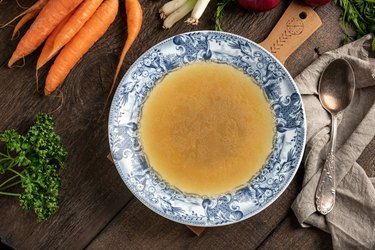
If you've just been through norovirus, you're likely exhausted from effects like diarrhea, nausea, vomiting, stomach cramps and loss of appetite. Welcome to the other side, when you get to focus on healing. Here's how to get back up to full strength, with a norovirus recovery diet.
Read more: The Best Foods to Eat With a Stomach Bug
Video of the Day
Video of the Day
Get Plenty of Liquids
Norovirus is one of the most prevalent forms of acute gastroenteritis, infecting 19 to 21 million people a year in the U.S., according to the Centers for Disease Control and Prevention (CDC). It is spread through direct contact with an infected person or eating foods contaminated with the virus.
Outbreaks can happen anytime, but they occur most often from November to April, which is why they're sometimes mistaken for the flu, the CDC says. The good news is that norovirus typically has a short duration, with symptoms lasting one to three days, it says.
The bad news? Those are some tough days. In addition to stomach problems, you may experience fever, headaches and body aches. There's no treatment except time, and people are encouraged to rest and drink fluids, the CDC says. Vomiting and diarrhea make staying hydrated difficult. That makes dehydration a big risk, along with its effects like dry mouth and dizziness.
Both during and after norovirus, replacing fluids and electrolytes should be a top priority, recommends Michigan dietitian Kelsey Lorencz, RDN. Electrolytes are minerals in your body required to maintain your blood chemistry, muscle action and other functions. She recommends electrolyte-infused water, no-sugar sports drinks and coconut water, and suggests avoiding carbonated beverages, caffeinated beverages and fruit juice, which may cause stomach upset.
For children, Mayo Clinic recommends offering a small amount of oral hydration solution like CeraLyte, Enfalyte and Pedialyte after your child's vomiting stops. Give frequent sips over a couple of hours, instead of a large amount at once, and gradually introduce easy-to-digest foods.
Consider the BRAT Diet
Ease back into eating after norovirus by consuming bland, easily digestible foods, Lorencz recommends. The first foods into your rotation can be bananas, rice, applesauce and toast, which make up what's called the BRAT diet. Though they are mild in terms of flavor, they also have simple sugars that can give you more energy. These low-fiber foods also make your stool firmer, aiding in your recovery from diarrhea.
"The BRAT diet lets your stomach take a little rest as you begin to build up strength after a stomach illness like norovirus," Lorencz says. "This is what to eat once you're past nausea and vomiting."
She suggests simple first meals like toast with a light spread of peanut butter for a little protein, as well as clear broth with saltine crackers, which can help replace sodium lost from vomiting and diarrhea. Definitely go for bananas, she suggests.
"These are part of the BRAT diet for good reason," she says. "The stomach often tolerates them well, and they're loaded with potassium, which may be low in your system after stomach issues. Try having a few slices on a graham cracker."
Once you're feeling better, begin to incorporate lean meats such as boiled chicken, as well as whole grains like barley and brown rice and lightly steamed vegetables. But, as the Mayo Clinic notes, if your nausea comes back, you should stop eating.
Ease Back Slowly
Once you're a few days past diarrhea and vomiting and feeling more hydrated and energetic, you can start to bring in foods from your typical diet. But even then, take it slow and eat small, frequent meals to let your body adjust, advises dietitian Justine Hays, RD, a certified dietitian nutritionist based in Buffalo, New York.
"Consuming too much at once may cause cramping, nausea, diarrhea or vomiting," she says. "If that happens, ease off the solid foods and try again in a few hours or when your stomach has settled."
Even then, she recommends avoiding highly spiced foods, as well as those that are high in fat or sugar because they can worsen gastrointestinal upset. Easing back slowly can help you regain strength and heal faster.
- Kelsey Lorencz, RDN, Michigan
- Justine Hays, RD, CDN, Buffalo, New York
- Centers for Disease Control and Prevention: "Burden of Norovirus Illness in the U.S."
- Centers for Disease Control and Prevention: "Norovirus"
- Centers for Disease Control and Prevention: "How You Treat Norovirus"
- Mayo Clinic: "Gastroenteritis: First Aid"
- CDC: "The Symptoms of Norovirus"
Is this an emergency? If you are experiencing serious medical symptoms, please see the National Library of Medicine’s list of signs you need emergency medical attention or call 911.